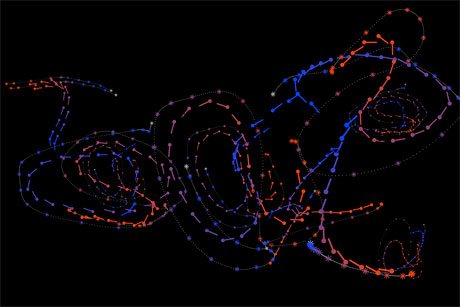Tiger beetle's chase highlights mechanical law
By Anne Ju

If an insect drew a line as it chased its next meal, the resulting pattern would be a tangled mess. But there’s method to that mess, says Jane Wang, professor of mechanical engineering and physics, who tries to find simple physical explanations for complex, hardwired animal behaviors.
It turns out the tiger beetle, known for its speed and agility, does an optimal reorientation dance as it chases its prey at blinding speeds. Publishing online April 9 in the Journal of the Royal Society Interface, Wang and colleagues used high-speed cameras and statistical analysis to reveal a proportional control law in which the angular position of prey, relative to the beetle’s body axis, drives the beetle’s angular velocity with a delay of 28 milliseconds. That’s about a half-stride in beetle terms.
These observations led Wang to propose a physical interpretation of the behavior: that to turn toward its prey, the beetle, on average, exerts a sideways force proportional to the prey’s angular position, measured a half-stride earlier.
“The idea is to find laws that animals use to intercept their prey,” Wang said. “We do it, too [interception] – when trying to catch a baseball, or when chasing someone. But since insects have a smaller number of neurons, their behaviors are more likely hardwired, which makes it possible for us to find and understand the rules they follow.”
Why the tiger beetle? It’s a nice model system, Wang said, which she learned after attending a talk several years ago by entomology professor Cole Gilbert, who studies neural mechanisms of behavior in arthropods and is a paper co-author. Andreas Haselsteiner, the paper’s first author, was a visiting student in Wang’s lab and designed the experiments.
For the experiments, a “dummy prey” – a black bead – was dangled in front of the beetle, which, mistaking the bead for a meal, would give chase. Its chasing patterns were recorded with a high-speed camera.
From their analysis emerged a macroscopic description of the animal’s movements, which reveals an internal time scale that governs the beetle’s sensing-to-actuation system and a close-to-optimal gain value in the control algorithm, Wang said.
From an evolutionary point of view, the sensing and moving are intimately connected, Wang continued. Some of the hundreds of thousands of neurons that function for sight are directly connected to the machinery for locomotion, which is directly related to the animal’s instinct to survive – that is, eat. Thus, studying how animals move can provide insight into how they sense their environment, and vice versa, she said.
Wang is on sabbatical at Janelia Farm Research Campus in Virginia, part of the Howard Hughes Medical Institute, exploring these ideas in studies of dragonfly flight.
Get Cornell news delivered right to your inbox.
Subscribe